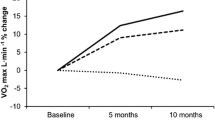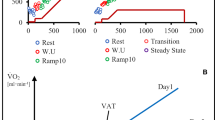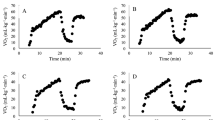Abstract
Purpose
To determine whether estimated maximal oxygen consumption (\({{e\dot{V}O}}_{2\max }\)) can detect cardiorespiratory fitness (CRF) changes by behavioral modifications. This study compared changes in measured \({\dot{\text{V}}}\)O2max (m\({\dot{\text{V}}}\)O2max) through exercise intervention with e\({\dot{\text{V}}}\)O2max using a multiple regression model (MRM) and linear extrapolation method (LEM).
Methods
A cross-sectional analysis involving 173 adults was conducted to establish an MRM by including age, sex, body mass index, questionnaire score, heart rate (HR) from step test, and m\({\dot{\text{V}}}\)O2max. Subsequently, 15 men participated in an intervention experiment comprising an 8-week, high-intensity interval training, followed by 8-week detraining, and completed anthropometric measurements, questionnaires, step tests, and m\({\dot{\text{V}}}\)O2max tests. m\({\dot{\text{V}}}\)O2max changes throughout the intervention were compared to e\({\dot{\text{V}}}\)O2max changes calculated using the MRM and LEM. The LEM used the HR during the step test with constant values (predetermined \({\dot{\text{V}}}\)O2), such as the Chester step test.
Results
Inclusion of the step test HR in a questionnaire-based MRM improved the estimation power, although the MRM underestimated higher m\({\dot{\text{V}}}\)O2max values. In the intervention, m\({\dot{\text{V}}}\)O2max increased by 20.0 ± 14.1% (P < 0.01) and subsequently decreased by 9.5 ± 6.6% (P < 0.01) after exercise training and detraining, respectively. Significant method × time interactions were observed between m\({\dot{\text{V}}}\)O2max and e\({\dot{\text{V}}}\)O2max in the MRM but not in the LEM, i.e., an apparent systematic error (underestimation of high values) of the MRM was absent in the LEM, although the correlation between m\({\dot{\text{V}}}\)O2max and e\({\dot{\text{V}}}\)O2max using the LEM was moderate.
Conclusion
e\({\dot{\text{V}}}\)O2max, particularly using the MRM with HR as an explanatory factor, is not an appropriate method for detecting CRF changes along with behavioral modifications.
Clinical trial registration
Registered number, UMIN000041031; Registered date, 2020/07/08; URL, https://center6.umin.ac.jp/cgi-open-bin/ctr_e/ctr_view.cgi?recptno=R000046855.



Similar content being viewed by others
Data availability
On reasonable request, derived data supporting the findings of this study are available from the corresponding author after approval from the Ethical Committee of the National Institute of Occupational Safety and Health, Japan.
Abbreviations
- BMI:
-
Body mass index
- bpm:
-
Beats per minute
- CRF:
-
Cardiorespiratory fitness
- CST:
-
Chester step test
- e\({\dot{\text{V}}}\)O2max :
-
Estimated maximal oxygen consumption
- HIIT:
-
High-intensity interval training
- HR:
-
Heart rate
- JST:
-
The National Institute of Occupational Safety and Health, Japan (J-NIOSH) step test
- LEM:
-
Linear extrapolation method
- LoA:
-
Limits of agreement
- MET:
-
Metabolic equivalent
- MRM:
-
Multiple regression model
- m\({\dot{\text{V}}}\)O2max :
-
Measured maximal oxygen consumption
- PA:
-
Physical activity
- PRESS:
-
Predicted residual error sum of squares
- R2 :
-
Coefficient of determination
- RPE:
-
Rating of perceived exertion
- SD:
-
Standard deviation
- SEE:
-
Standard error of the estimate
- \({\dot{\text{V}}}\)O2max :
-
Maximal oxygen consumption
References
Arena R, Myers J, Kaminsky LA (2016) Revisiting age-predicted maximal heart rate: can it be used as a valid measure of effort? Am Heart J 173:49–56. https://doi.org/10.1016/j.ahj.2015.12.006
Bennett H, Parfitt G, Davison K, Eston R (2016) Validity of submaximal step tests to estimate maximal oxygen uptake in healthy adults. Sports Med 46(5):737–750. https://doi.org/10.1007/s40279-015-0445-1
Billinger SA, E VS, McClain M, Lentz AA, Good MB (2012) Recumbent stepper submaximal exercise test to predict peak oxygen uptake. Med Sci Sports Exerc 44(8):1539–1544. https://doi.org/10.1249/MSS.0b013e31824f5be4
Buckley JP, Sim J, Eston RG, Hession R, Fox R (2004) Reliability and validity of measures taken during the Chester step test to predict aerobic power and to prescribe aerobic exercise. Br J Sports Med 38(2):197–205
Chatterjee S, Chatterjee P, Mukherjee PS, Bandyopadhyay A (2004) Validity of Queen’s College step test for use with young Indian men. Br J Sports Med 38(3):289–291. https://doi.org/10.1136/bjsm.2002.002212
Cuenca-Garcia M, Marin-Jimenez N, Perez-Bey A, Sanchez-Oliva D, Camiletti-Moiron D, Alvarez-Gallardo IC, Ortega FB, Castro-Pinero J (2022) Reliability of field-based fitness tests in adults: a systematic review. Sports Med 52(8):1961–1979. https://doi.org/10.1007/s40279-021-01635-2
Gallagher JR, Brouha LV (1943) A simple method of evaluating fitness in boys: the step test. Yale J Biol Med 15(6):769–779
Gupta S, Rohatgi A, Ayers CR, Willis BL, Haskell WL, Khera A, Drazner MH, de Lemos JA, Berry JD (2011) Cardiorespiratory fitness and classification of risk of cardiovascular disease mortality. Circulation 123(13):1377–1383. https://doi.org/10.1161/CIRCULATIONAHA.110.003236
Hansen D, Jacobs N, Thijs H, Dendale P, Claes N (2016) Validation of a single-stage fixed-rate step test for the prediction of maximal oxygen uptake in healthy adults. Clin Physiol Funct Imaging 36(5):401–406. https://doi.org/10.1111/cpf.12243
Holiday DB, Ballard JE, McKeown BC (1995) PRESS-related statistics: regression tools for cross-validation and case diagnostics. Med Sci Sports Exerc 27(4):612–620
Howley ET, Bassett DRJ, Welch HG (1995) Criteria for maximal oxygen uptake: review and commentary. Med Sci Sports Exerc 27(9):1292–1301
Jang WY, Kang DO, Park Y, Lee J, Kim W, Choi JY, Roh SY, Jang Y, Park SH, Kim WS, Na JO, Choi CU, Rha SW, Park CG, Seo HS, Kim EJ (2020) Validation of FRIEND and ACSM equations for cardiorespiratory fitness: comparison to direct measurement in CAD patients. J Clin Med 9(6):1889. https://doi.org/10.3390/jcm9061889
Kodama S, Saito K, Tanaka S, Maki M, Yachi Y, Asumi M, Sugawara A, Totsuka K, Shimano H, Ohashi Y, Yamada N, Sone H (2009) Cardiorespiratory fitness as a quantitative predictor of all-cause mortality and cardiovascular events in healthy men and women: a meta-analysis. JAMA 301(19):2024–2035. https://doi.org/10.1001/jama.2009.681
Kokkinos P, Kaminsky LA, Arena R, Zhang J, Myers J (2017) New generalized equation for predicting maximal oxygen uptake (from the fitness registry and the importance of exercise national database). Am J Cardiol 120(4):688–692. https://doi.org/10.1016/j.amjcard.2017.05.037
Lannoy DEL, Ross R (2020) Nonexercise equations for determining change in cardiorespiratory fitness. Med Sci Sports Exerc 52(7):1525–1531. https://doi.org/10.1249/MSS.0000000000002284
Laukkanen JA, Rauramaa R, Salonen JT, Kurl S (2007) The predictive value of cardiorespiratory fitness combined with coronary risk evaluation and the risk of cardiovascular and all-cause death. J Intern Med 262(2):263–272. https://doi.org/10.1111/j.1365-2796.2007.01807.x
Lee O, Lee S, Kang M, Mun J, Chung J (2019) Prediction of maximal oxygen consumption using the Young Men’s Christian Association-step test in Korean adults. Eur J Appl Physiol 119(5):1245–1252. https://doi.org/10.1007/s00421-019-04115-8
Malek MH, Housh TJ, Berger DE, Coburn JW, Beck TW (2004) A new nonexercise-based VO2max equation for aerobically trained females. Med Sci Sports Exerc 36(10):1804–1810. https://doi.org/10.1249/01.mss.0000142299.42797.83
Matsuo T, Saotome K, Seino S, Eto M, Shimojo N, Matsushita A, Iemitsu M, Ohshima H, Tanaka K, Mukai C (2014a) Low-volume, high-intensity, aerobic interval exercise for sedentary adults: VO2max, cardiac mass, and heart rate recovery. Eur J Appl Physiol 114(9):1963–1972. https://doi.org/10.1007/s00421-014-2917-7
Matsuo T, Saotome K, Seino S, Shimojo N, Matsushita A, Iemitsu M, Ohshima H, Tanaka K, Mukai C (2014b) Effects of a low-volume aerobic-type interval exercise on VO2max and cardiac mass. Med Sci Sports Exerc 46(1):42–50. https://doi.org/10.1249/MSS.0b013e3182a38da8
Matsuo T, So R, Takahashi M (2020a) Estimating cardiorespiratory fitness from heart rates both during and after stepping exercise: a validated simple and safe procedure for step tests at worksites. Eur J Appl Physiol 120(11):2445–2454. https://doi.org/10.1007/s00421-020-04457-8
Matsuo T, So R, Takahashi M (2020b) Workers’ physical activity data contribute to estimating maximal oxygen consumption: a questionnaire study to concurrently assess workers’ sedentary behavior and cardiorespiratory fitness. BMC Public Health 20(1):22. https://doi.org/10.1186/s12889-019-8067-4
Myers J, Prakash M, Froelicher V, Do D, Partington S, Atwood JE (2002) Exercise capacity and mortality among men referred for exercise testing. N Engl J Med 346(11):793–801. https://doi.org/10.1056/NEJMoa011858
Nakamura E, Miyao K, Ozeki T (1988) Assessment of biological age by principal component analysis. Mech Ageing Dev 46(1–3):1–18. https://doi.org/10.1016/0047-6374(88)90109-1
Nes BM, Janszky I, Vatten LJ, Nilsen TI, Aspenes ST, Wisløff U (2011) Estimating VO2peak from a nonexercise prediction model: the HUNT Study. Norway Med Sci Sports Exerc 43(11):2024–2030. https://doi.org/10.1249/MSS.0b013e31821d3f6f
Peterman JE, Harber MP, Imboden MT, Whaley MH, Fleenor BS, Myers J, Arena R, Finch WH, Kaminsky LA (2020) Accuracy of nonexercise prediction equations for assessing longitudinal changes to cardiorespiratory fitness in apparently healthy adults: BALL ST cohort. J Am Heart Assoc 9(11):e015117. https://doi.org/10.1161/JAHA.119.015117
Peterman JE, Whaley MH, Harber MP, Fleenor BS, Imboden MT, Myers J, Arena R, Kaminsky LA (2021) Comparison of non-exercise cardiorespiratory fitness prediction equations in apparently healthy adults. Eur J Prev Cardiol 28(2):142–148. https://doi.org/10.1177/2047487319881242
Riebe D, Ehrman JK, Liguori G, M M (2017) Clinical exercise testing and interpretation. In: D R (ed) ACSM's Guidelines for Exercise Testing and Prescription 10th edition. Wolters Kluwer, Philadelphia, pp 111–142
Ross R, Blair SN, Arena R, Church TS, Despres JP, Franklin BA, Haskell WL, Kaminsky LA, Levine BD, Lavie CJ, Myers J, Niebauer J, Sallis R, Sawada SS, Sui X, Wisloff U, American Heart Association Physical Activity Committee of the Council on L, Cardiometabolic H, Council on Clinical C, Council on E, Prevention, Council on C, Stroke N, Council on Functional G, Translational B, Stroke C (2016) Importance of assessing cardiorespiratory fitness in clinical practice: a case for fitness as a clinical vital sign: a scientific statement from the american heart association. Circulation 134(24):e653–e699. https://doi.org/10.1161/CIR.0000000000000461
Santo AS, Golding LA (2003) Predicting maximum oxygen uptake from a modified 3-minute step test. Res Q Exerc Sport 74(1):110–115. https://doi.org/10.1080/02701367.2003.10609070
Sarzynski MA, Rankinen T, Earnest CP, Leon AS, Rao DC, Skinner JS, Bouchard C (2013) Measured maximal heart rates compared to commonly used age-based prediction equations in the Heritage Family Study. Am J Hum Biol 25(5):695–701. https://doi.org/10.1002/ajhb.22431
So R, Matsuo T (2020) Effects of using high-intensity interval training and calorie restriction in different orders on metabolic syndrome: a randomized controlled trial. Nutrition. https://doi.org/10.1016/j.nut.2019.110666
Tanaka H, Monahan KD, Seals DR (2001) Age-predicted maximal heart rate revisited. J Am Coll Cardiol 37(1):153–156. https://doi.org/10.1016/s0735-1097(00)01054-8
Teren A, Zachariae S, Beutner F, Ubrich R, Sandri M, Engel C, Loffler M, Gielen S (2016) Incremental value of Veterans Specific Activity Questionnaire and the YMCA-step test for the assessment of cardiorespiratory fitness in population-based studies. Eur J Prev Cardiol 23(11):1221–1227. https://doi.org/10.1177/2047487315621844
Webb C, Vehrs PR, George JD, Hager R (2014) Estimating VO2max using a personalized step test. Meas Phys Educ Exerc Sci 18(3):184–197. https://doi.org/10.1080/1091367X.2014.912985
Wier LT, Jackson AS, Ayers GW, Arenare B (2006) Nonexercise models for estimating VO2max with waist girth, percent fat, or BMI. Med Sci Sports Exerc 38(3):555–561. https://doi.org/10.1249/01.mss.0000193561.64152
Acknowledgements
We thank the researchers and staff members of the National Institute of Occupational Safety and Health, Japan, and the THF Corporation for their support in this study.
Author information
Authors and Affiliations
Contributions
The contributions of each author were as follows: TM contributed to developing study concept and design, data acquisition, data analysis, and manuscript writing; RS contributed to developing study concept and design, data acquisition, data analysis, and manuscript revisions; FM contributed to data acquisition, data analysis, and manuscript revisions. All authors read and approved the final version of the manuscript.
Corresponding author
Ethics declarations
Conflict of interests
The authors have no competing interests to declare that are relevant to the content of this article. This study was financially supported by Industrial Disease Clinical Research Grants from the Japanese Ministry of Health, Labour and Welfare (180902–01) and by funding from the National Institute of Occupational Safety and Health, Japan (N-P02-02).
Ethics approval
This study was conducted in accordance with the guidelines proposed in the Declaration of Helsinki. The Ethical Committee of the National Institute of Occupational Safety and Health, Japan reviewed and approved the study protocol (ID H2744 and 2019N35).
Informed consent
Written informed consent was obtained from all participants after explaining to them the aims and design of this study.
Additional information
Communicated by I. Mark Olfert.
Publisher's Note
Springer Nature remains neutral with regard to jurisdictional claims in published maps and institutional affiliations.
Supplementary Information
Below is the link to the electronic supplementary material.
Rights and permissions
Springer Nature or its licensor (e.g. a society or other partner) holds exclusive rights to this article under a publishing agreement with the author(s) or other rightsholder(s); author self-archiving of the accepted manuscript version of this article is solely governed by the terms of such publishing agreement and applicable law.
About this article
Cite this article
Matsuo, T., So, R. & Murai, F. Estimation methods to detect changes in cardiorespiratory fitness due to exercise training and subsequent detraining. Eur J Appl Physiol 123, 877–889 (2023). https://doi.org/10.1007/s00421-022-05113-z
Received:
Accepted:
Published:
Issue Date:
DOI: https://doi.org/10.1007/s00421-022-05113-z




